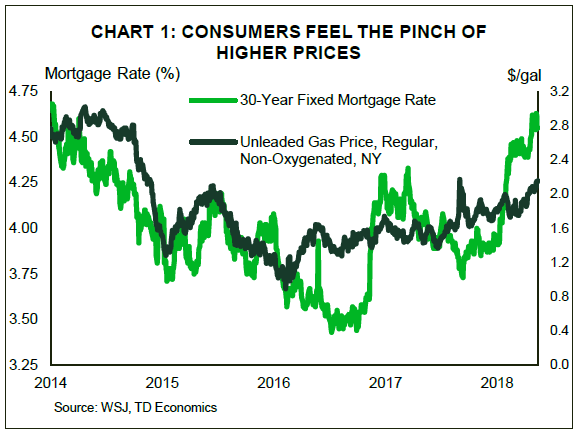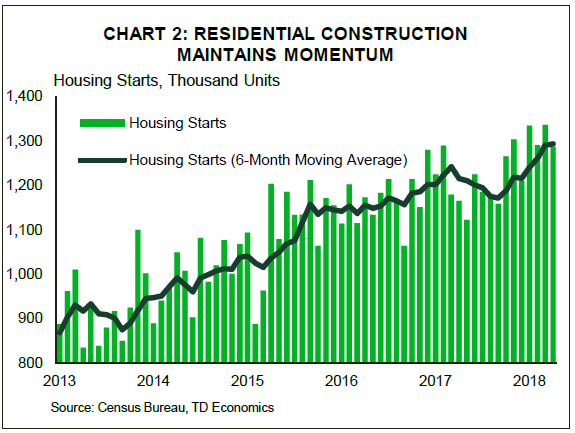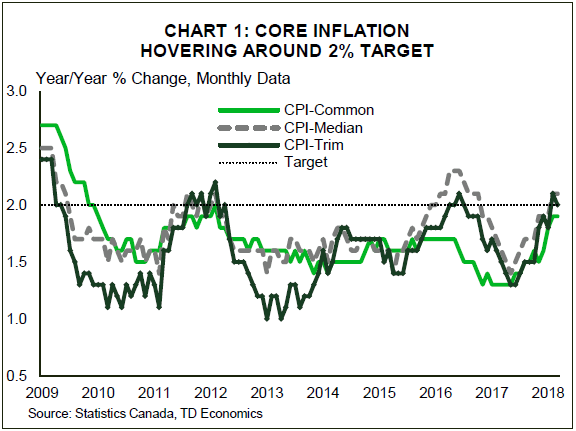U.S. Highlights
- Equity markets were buffeted by plenty of anxiety-producing events from uncertainty on trade negotiations to right wing coalitions in Italy. Americans may also be a bit nervous about higher prices, both at the pump and for borrowing.
- The rise in oil prices is expected to be a modest drag on consumer spending. Ditto for mortgage rates and the housing market. Much of this was anticipated, and had already been baked in to our last quarterly forecast.
- We continue to expect growth to run around 3% over the remaining quarters of 2018 as the boost from fiscal stimulus offsets these modest headwinds.
Canadian Highlights
- It was another good week for Canadian equity investors. As of writing, the TSX looks to have finished the week comfortably above the 16,000 mark, up close to 1%, and at its highest level since January.
- Fixed income investors on the other hand, weren’t so fortunate as bonds sold off across the curve, with selling more acute at the long end. Canadian 5 and 10-year yields rose over 10 basis points, following their U.S. counterparts higher.
- The magnetic pull higher from U.S. yields is tightening financial conditions in Canada. As long as the inflation outlook remains benign, the Bank of Canada can maintain their cautious approach. The data this week support that narrative. Canadian CPI inflation decelerated to 2.2% in April (from 2.3%) in March.
U.S. – Onwards and Upwards
The past week featured plenty of events for equity markets to fret about, from uncertainty surrounding U.S. trade negotiations, to a eurosceptic right-wing coalition in Italy. Concerns about emerging markets (EM) have led to the worst week for EM currencies in a year and a half, as the U.S. dollar continues to rise. And for Americans, it seems like everything is going up these days, from mortgage rates to gasoline prices (Chart 1).
Drivers may be getting sticker shock as they fill up their tanks, with the national average gasoline price approaching $3 per gallon. However, about half of the 10% rise in gasoline prices since March is the typical seasonal increase. Still, this will leave a bit less cash in wallets for spending on discretionary items. To put some numbers to it, in 2017 each American consumed about 442 gallons of gasoline per year, so a 5% increase works out to about $62/month for a family of four.
Higher oil prices are acting to drive inflation expectations, and consequently Treasury yields, higher. The 10-Year yield reached 3.11% on Thursday, the highest level since mid-2011. For much of last year, we argued bond yields were too low, and now things are looking much more reasonable. What’s more, the latest readings on the economy are consistent with higher bond yields. A healthy retail report for April demonstrated that consumers are back in action after taking a breather in Q1 Consumer spending growth in the second quarter is tracking close to 3% annualized, which would help to support a similar growth tally for the economy as a whole.
Mortgage rates have followed Treasury yields higher. The average rate on a 30-year fixed-rate mortgage rose to 4.61% this week, very close to the 2013 taper tantrum episode highs. The impact of higher mortgage rates is less far reaching than gasoline prices. It will only affect new borrowers and homeowners who are refinancing. The average new mortgage was $317,300 in March, so the impact of the 74 basis point increase in rates since the beginning of the year will raise the average monthly payment about $138 per month. This should hinder affordability in the housing market, and lean against demand.
That said, we remain confident that the positive fundamentals for housing will underpin gains in residential construction going forward. Housing starts may have been off a bit in April, but looking through the monthly volatility, the trend in the forward-looking permits data is still positive (Chart 2). Moreover, the monthly decline was due to the always volatile multi-family component. True, there are headwinds to homebuilding activity, including labor shortages in the construction industry, rising building material costs and a lack of buildable lots. But, after some weakness over the winter, homebuilder sentiment took a tentative step higher in May, suggesting these barriers are not insurmountable.
The pinch of higher prices and borrowing rates is expected to restrain consumer spending and housing investment slightly versus 2017’s performance. But, for the remainder of 2018 we expect business investment and government spending to power real GDP growth of around 3%.
Canada – Equities Move Higher And So Do Yields
It was another good week in what has been a good month for Canadian equity investors. As of writing, the TSX looks to have finished the week comfortably above the 16,000 mark, up close to 1%, and at its highest level since January. Higher oil prices have no doubt contributed to the TSX’s fortunes. The WTI price continued to move higher this week, up around 1% to push above the $71.50 U.S. a barrel mark.
Fixed income investors on the other hand, weren’t so fortunate, as bonds sold off across the curve, with selling more acute at the long end. Canadian 5 and 10-year yields rose over 10 basis points, following their U.S. counterparts higher.
The magnetic pull higher from U.S. yields is tightening financial conditions in Canada even without any change to the Bank of Canada’s policy rate. Higher yields will make their way to mortgage rates, worsening affordability in a housing market that is already stretched. Data this week on existing home sales shows the market continues to struggle. Existing home sales fell 2.9% in April – the fourth straight monthly decline, while average prices were basically flat at their lowest level since 2005.
The recent rise in yields has come faster than our baseline expectation, and while some reversal may take place, they do not help an already precarious housing outlook. Rising borrowing costs are front and center to the Bank of Canada’s economic monitoring. Given the level of household debt, the sensitivity of Canadian households to higher interest rates is higher than it has been historically.
This means that as long as the inflation outlook remains benign, the Bank of Canada can maintain their cautious approach. The data this week support that narrative. Canadian CPI inflation decelerated to 2.2% in April (from 2.3%) in March, while the average of the Bank of Canada’s core inflation measures remained steady at 2.0%. Headline inflation is likely to be lifted by the steady rise in oil prices over the past month, but beyond that price pressures look to be fairly well contained. With some temporary factors at work (higher minimum wages) and Poloz’s emphasis on the symmetry of the Bank’s inflation target, there appears little on the price front to force the Bank’s hand.
A more cautious Bank of Canada relative to the U.S. is weighing on the Canadian dollar. Despite the rise in oil, the Canadian dollar looks to finish the week lower, at around the $0.78 U.S. mark. Indeed, the usual positive correlation between oil prices and the exchange rate has not been as strong of late, reflecting both uncertainty around Canadian pipeline capacity (and investment) and the expected increase in U.S. production (and investment).
The other factor weighing on the Canadian dollar is, of course, ongoing uncertainty with respect to NAFTA. While Prime Minister Trudeau expressed his optimism that a deal was close, this was dismissed by the United States Trade Representative, Robert Lighthizer who noted ongoing differences on intellectual property, agricultural access, labor and energy. Uncertainty around NAFTA falls disproportionately on Canada and Mexico, and the exchange rate bears this out.



















